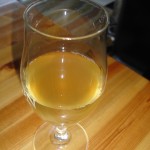Well I hate Christmas, and all the other “Hallmark Holidays” surrounding it. Rushing around visiting people you luckily only have to deal with maybe twice a year, yeah thats always a JOY. So I decided to make something to at least help take the edge off of it. A cranberry infused holiday ale.
As is normal we started with a simple recipe and then twisted it up a bit. I found a simple partial mash recipe online and we deviated from it just a bit, well probably a little bit more than that. For our main base malts we used 2 cans of Liquid malt extract. One Briess Golden, the other a Briess Bavarian Wheat. The only specialty grain used was 1lb of Crystal (25L). Also around 2lbs of honey was added to the boil, this beer has the potential to be as sweet as me!
Since only a small amount of grain was used, I was able to steep it on the stove in a medium sized pot. I kept it at a temp of around 160 for 25 minutes before adding it to our electric brew kettle, which already had some water heating up in it. I then sparged the grains with some hot water and continued to bring everything up to a boil. Once a nice boil was achieved both cans of malt extract and the honey were added. That cooled the kettle down just a bit and I waited till it came back to a boil before it was hop time.
Our hop schedule was fairly simple on this beer since it wasn’t going to be an overly hoppy beer. A 1 hour boil was planned and the first addition was 1oz. of Willamette. We then played the waiting game for half an hour, and relaxed watching some more 3 stooges(see Pilsner post). At the half hour mark 1/2oz. of Kent Goldings hops was added, along with the peel of 3 oranges and some spices like nutmeg and cinnamon. Boy if this beer doesn’t taste good I’m it coulu just be warmed on the stove and used as an air freshner. Our last addidtion came at ten minutes from the end of boil, which was our last half of the Kent Goldings. The final ten minutes of boil and then removed from the heat.
Upon terminating the boil I added some cranberry. Now I don’t much like fruity beers, and don’t want a whole lot of fruit taste, but I think a little may not hurt. And Cranberry sounded good in a wheat beer. So I only added an 8oz. can of cranberry sauce. I didn’t want to mess with the actual berries, so that seemed like the next best thing. Hopefully it gives just a hint of flavor to our beer.
The mash tun was cooled, then added to our primary fermenter bucket. I filled it back up to 5 gallons with cool water and then let it settle back down to around 75 degrees. A gravity reading at this time was at 1.064, which should leave a fairly high alcohol beer. PERFECT! I added a packet of Safbrew wheat ale yeast, and placed the lid on the bucket and went back to watching my stooges. By morning a good amount of bubbles were forming, and the smell was delightful. Spices and hops really hit my nose when I opened the bucket. Lets see how it turns out in a few weeks.
Ian
